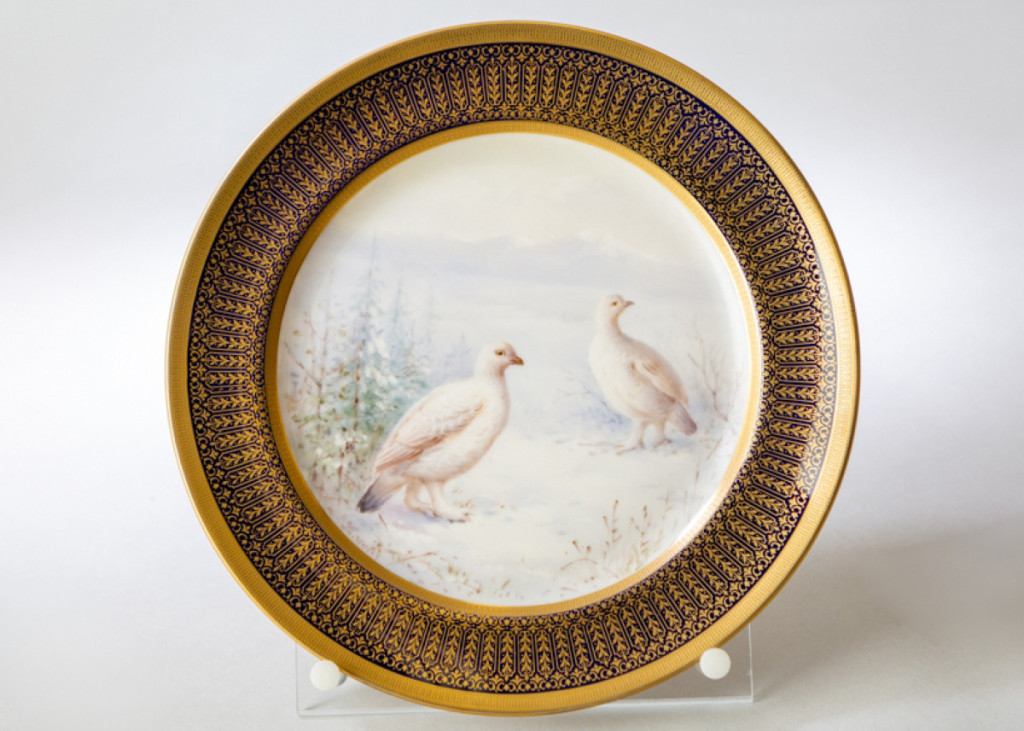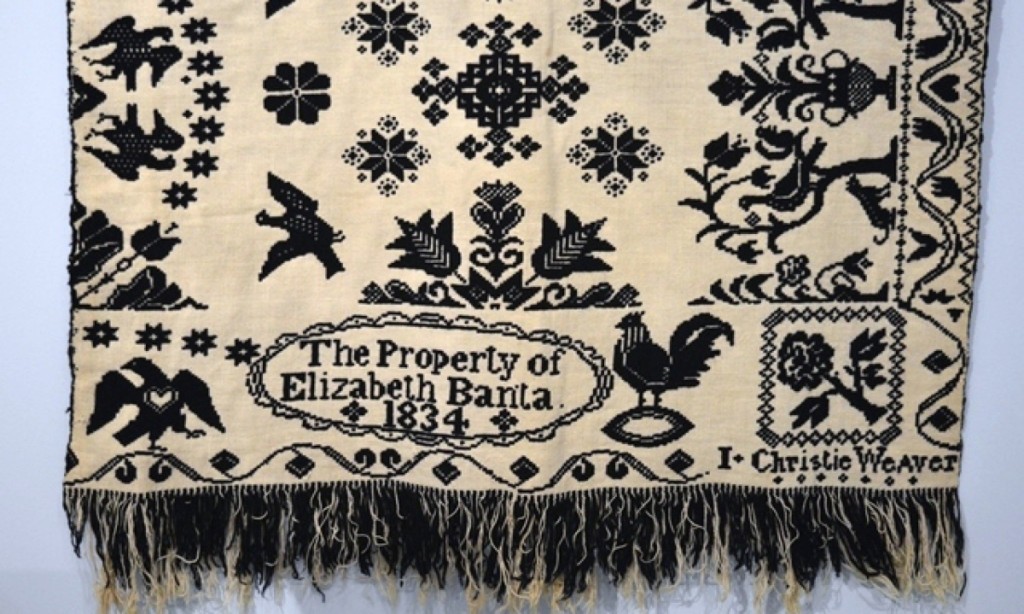
This piece is a complete lesson on a popular backyard species. We learn about habitat, habits, gender roles and food sources. Boehm placed a green anole lizard in the scene to show the bird’s raucous nature. Blue jays are famous for issuing loud alarm calls when intruders enter their habitat. “Blue Jays on Strawberries” by Edward Marshall Boehm (1913-1969), Trenton, N.J., 1962-1966. Porcelain. Collection of New Jersey State Museum, Gift of Mr and Mrs O.H. Delchamps.
By Kristin Nord
TRENTON, N.J. – Whether it’s warblers or wading birds, falcons or finches, New Jersey is an avian hot spot – a state where the number of species counted annually draws birders eager to add to their life lists.
It was perhaps with these demographics in mind that Nicholas P. Ciotola and Dana J. Ehret, co-curators of “Fine Feathered Friends: Birds as Mainstay and Muse,” envisioned an exhibition that would appeal to budding citizen naturalists of all ages.
“Because we draw such a diverse audience, we wanted to take an interdisciplinary approach that merges history, art and science,” Ciotola explained. The end result is an array of objects that can be appreciated on several levels, both for their aesthetic beauty and as a part of New Jersey’s story overall.
For the show, which opened recently at New Jersey State Museum, “We were very strict about drawing only from our existing collections,” Ciotola said. “Of course, we could have borrowed any number of complementary objects, but we wanted to deliver the message of highlighting what we have in our own storage.” And the approximately 200 objects selected from its natural history and decorative arts departments have quite a story to tell.
By the late Nineteenth Century, Trenton was a fast-growing urban center, known as the “Staffordshire of America” in reference to the industrial potteries of the English Midlands where many Trenton potters originally had learned their trade. A vibrant ceramics industry thrived for decades, producing utilitarian dinnerware in more than 50 factories and top-of-the-line art porcelain. Walter Scott Lenox’s Ceramic Art Company would become famous for their hand-painted dining plates: Lenox’s bone china would be used for holidays in many American homes and commissioned as custom tableware for six US presidents.
Common and exotic birds were favored decorative motifs, and appeared on hand-blown glass bottles, flasks, vases, as well as tableware and even architectural ornaments. And the bald eagle became a potent symbol, as seen in a rare yellowware pitcher, “designed to underscore William Henry Harrison’s patriotism” in his bid for president.
Birds were iconic elements in schoolgirl needlework samplers, with common birds suggesting the connections between humans and the natural world and exotic birds, like those featured in Ruth Brown’s South Jersey sampler, believed to have been inspired by tales of exploration.
New Jersey’s coastal waterway, with its proximity to New York and Philadelphia, became a prime duck hunting region by the late Nineteenth Century. Canvasbacks, brants and golden plovers were revered as gourmet delicacies. A vibrant decoy carving tradition sprang up, and the museum is showcasing some pieces that have not been seen in a half-century.
“Here in New Jersey, there are two general styles of decoys – a Coastal style and a Delaware River style,” Ciotola said. “There are some differences between the two and some general rules of thumb, but always exceptions. Coastal carvers used white cedar wood; river carvers used red cedar or pine.”
“The hollow-carved tradition developed in both coastal and river regions. The carver made two halves and hollowed them out and attached them together. If you look closely you can see the seams.” Hollow decoys were designed for small flat-bottomed boats known as sneakboxes, he continued, which couldn’t take much weight when rigged.

Ptarmigan turn white in winter in order to blend in with their snowy surroundings and hide from predators. They are the only bird that molt into all-white feathers every year. This porcelain plaque by William H. Morley features hand-painted ptarmigan in full winter plumage. Plaque with Ptarmigan, Lenox, Inc., decorated by William H. Morley (1869-1934), Trenton, N.J., circa 1910. Porcelain. Collection of New Jersey State Museum. Gift of Brown-Forman Corporation.
The acclaimed coastal carver Harry Vinuckson Shourds (1861-1920) is credited with making thousands of duck, goose, brant and shorebird decoys. His red-breasted merganser decoy made circa 1910 is an exhibition standout, with other works, carved by Ephraim Hildreth, Cape May (1830-1915), James C. Kemble, Trenton (1862-1927), Joe Paul, Manahawkin (1881-1951), Jay Parker (1881-1967), Hurley Conklin, Manahawkin (1913-1991), and Lloyd Johnson, Bay Head (1910-1965) – attesting to the rich diversity of this folk art tradition.
While birds inspired New Jersey artists and entrepreneurs, by the late Eighteenth Century they were also, increasingly, under assault. In one famous recounting, the revered New Jersey ornithologist, Frank Chapman, in a random perambulation around Manhattan, encountered some 700 hats decorated with 40 native bird species. Chapman became an early advocate for the species that were being killed, plucked and stuffed in the name of fashion. And New Jersey itself began to play a prominent role in the national conservation movement with establishment of the New Jersey Audubon Society in 1897.
Wall text offers visitors a bit of a crash course in ornithology, as Ehret details the ways in which birds communicate and nest as well as how they are wired for memory and decision making.
From the red knot – which stops each year to refuel on horseshoe crab eggs in the Delaware Bay region on its annual migration from the southern tip of South America to its arctic breeding grounds – to crows and ravens, which distinguish themselves as extraordinarily clever foragers, these species make for lively company. Children undoubtedly will marvel at the great horned owl’s ability to rotate its head 180 degrees, not to mention its skill at severing spines with its strong talons.
The Northern cardinal, celebrated for its song, elegant motion and stunning year-round plumage, inspired many artists. It was this remarkable bird who landed on the windowsill of Edward Marshall Boehm’s Titusville, N.J., home one morning as his wife readied for church. The artist, whose fine art porcelain sculptures would become world-renowned, was said to have pronounced, “There is my religion.”

Red-breasted mergansers are carnivorous diving ducks. They have fine serrations along their bill, which help them to hold onto fish. Hunters liked to hunt them not for their taste, but because they were viewed as intelligent adversaries. Red-breasted merganser decoy carved by Harry V. Shourds (1861-1928), Tuckerton, N.J., circa 1880s. White cedar (hollow-carved). Collection of New Jersey State Museum.
Boehm (1913-1969) built and maintained extensive aviaries on his property, and his astute observations took great effect in works that were coveted for their scientific accuracy as well as their beauty. His featured birds were hand-assembled from molds and hand-painted by a team of artists. “Blue Jays on Strawberries” is a particularly masterful evocation of the species in sitü. “Mockingbirds on Blossoming Bindweed,” 1961-66, presented by New Jersey Governor Richard J. Hughes to President Lyndon B. Johnson as a gift from the Democratic Party at its 1964 National Convention in Atlantic City, is an example of a series of valued works that were commissioned for diplomats and acquired by major museums.
New Jersey was blessed to have an expert anatomist and artist in service as the state’s first taxidermist, and we see the brilliant work of William H. Werner, in conjunction with the Boehm collection, displayed to great effect. In this century-old collection, which has been cleaned and primped, we also encounter a number of birds, including the Carolina parakeet and the passenger pigeon, which have become extinct.
Original prints from John James Audubon’s (1785-1851) “Double Elephant Folio” edition of his Birds of North America round out the show, including his famous depiction of an osprey in flight with a fish in its talons. This etching was inspired by a research trip to Egg Harbor on the Jersey Shore during the summer of 1829, when he lived and worked in Camden.
Ultimately, and perhaps this is the fundamental question the exhibition’s co-curators hope families will explore together: why do birds matter?
We now know that common bird species are vital to ecosystems; they control pests, pollinate flowers, spread seeds and regenerate forests. Increasingly we’ve learned that they are valuable indicators of pollution, habitat quality and biodiversity. They are also predictors of disease.
And alarmingly they are disappearing at an astonishing rate.
The 2019 State of the Birds Report published by the US Committee of the North American Bird Conservation Initiative, a coalition of 29 federal and state agencies, nonprofits and bird-focused partnerships concluded that “America’s birds are in crisis.” The pronouncement landed on the heels of a similarly dire study that appeared in the journal Science, reporting there has been a net loss of 3 billion birds in the United States and Canada since 1970.

This double-woven coverlet features doves, eagles and roosters. It is one half of the coverlet, which came off the loom in two pieces and would have been stitched together to form a finished blanket. This piece is almost identical to a coverlet by another Bergen County weaver, David Haring, suggesting that the two worked together. Coverlet with Birds, made by I. (J?) Christie for Elizabeth Banta, Bergen County, N.J., 1834. Wool and cotton. Collection of New Jersey State Museum.
The issue has been hitting home personally for New Jersey, where its state bird, the goldfinch, is now listed among the 389 species that are threatened by climate change. With the projected temperature increase of three degrees celsius, a recent National Audubon report has predicted the goldfinch could lose up to 100 percent of its summer range. The species, known for its stunning plumage, is already increasingly moving north to breed and nest. There could well be a time in the not-too-distant future when the state bird only returns to the state during winter months when it has turned a muted gray-green.
It is sobering to see that the need for intensified advocacy is more urgent for bird lovers than it was in 1911, when New Jersey Audubon widely distributed goldfinch buttons for its under-18-year-old members in an educational campaign. In “Fine Feathered Friends,” children are once again being asked to design and wear their own buttons – and to educate themselves on the impact of climate change.
And so, it would seem if we love our birds, we must fight for them. As the evidence continues to accrue, slowing the pace of climate change has become our great task. One can only hope that 2020 will be a fateful year for changing the politics of climate and of renewed advocacy for our feathered friends.
The New Jersey State Museum is at 205 West State Street. For additional information, 609-292-6464 or www.statemuseum.nj.gov.



















